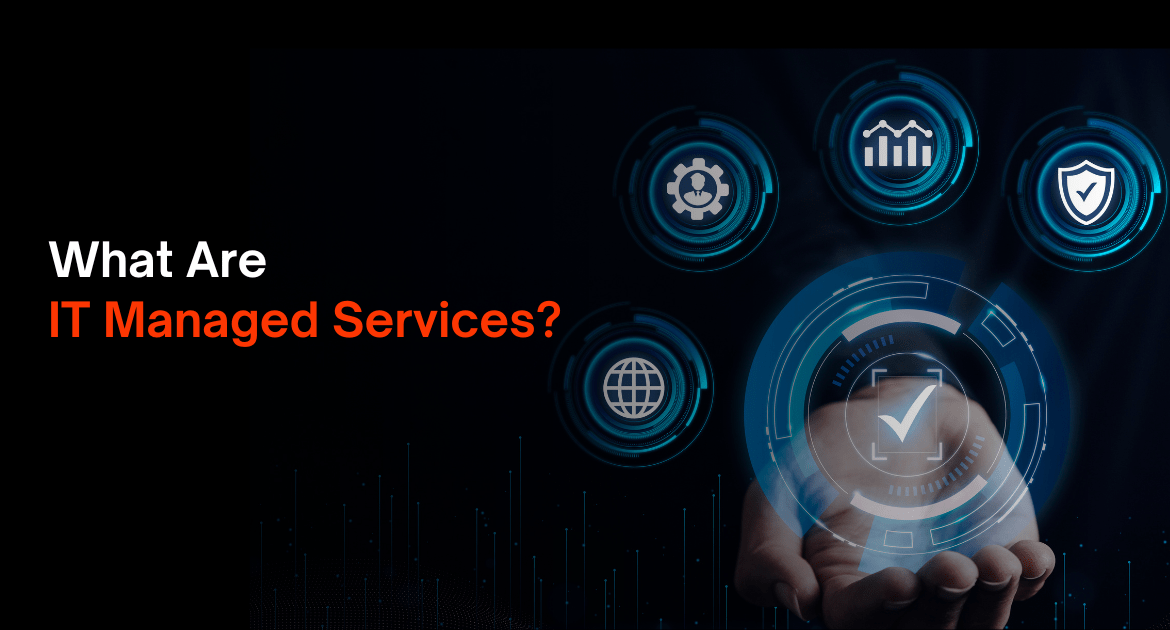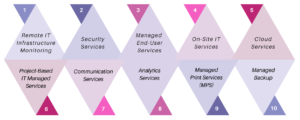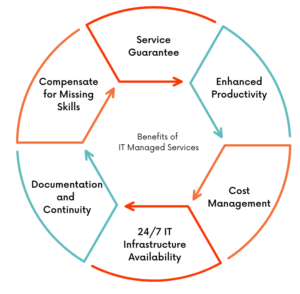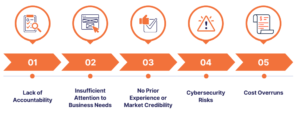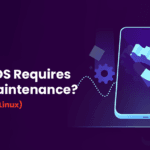Managing IT infrastructure effectively is crucial for businesses of all sizes. However, keeping up with the ever-evolving technology landscape can be challenging. This is where IT Managed Services come into play. IT Managed Services are defined as the practice of fully or partially outsourcing the migration, implementation, maintenance, and upgrade of different parts of IT infrastructure (including backup and security) to a third-party vendor who typically operates remotely or from an offshore location. The solution rendered comprises IT Managed Services, and the solution provider is called the Managed Service Provider (MSP).
What Are IT Managed Services?
IT Managed Services refer to outsourcing various IT functions to a third-party vendor. This can include everything from managing network security to overseeing data migration and providing regular maintenance and upgrades. The primary goal of IT Managed Services is to shift the burden of IT management from the client to the service provider, allowing businesses to focus on their core activities. The MSP, or Managed Service Provider, is responsible for delivering these services, often from a remote location, ensuring that the client’s IT infrastructure runs smoothly and efficiently.
Types of IT Managed Services
- Remote IT Infrastructure Monitoring: A common category of IT Managed Services is the remote monitoring and management of servers, workstations, and mobile devices. This service ensures that all aspects of an organization’s IT infrastructure are functioning correctly and efficiently. Remote monitoring helps identify and address issues before they can disrupt operations, providing a proactive approach to IT management. With competition in this area being fierce, MSPs are continually refining their offerings to provide better, more specialized services.
- Security Services: With the increasing number of cybersecurity threats, IT Managed Services now often include managed security services. These services are designed to protect an organization’s IT systems and data from cyberattacks. MSPs offering security services might provide firewall management, antivirus protection, intrusion detection, and response to ensure that their clients’ data remains secure. This specialization has become crucial as businesses face more sophisticated and frequent cyber threats.
- Managed End-User Services: End-user services focus on the IT support provided directly to employees and customers. This can include help desk support, troubleshooting technical issues, assisting with software installations, and ensuring that all end-user devices are functioning properly. By providing these services, MSPs help improve the overall user experience, making sure that employees can work efficiently without IT-related interruptions.
- On-Site IT Services: Sometimes referred to as managed field services, on-site IT services involve MSPs sending technicians to the client’s location to perform various tasks. These tasks can range from installing and maintaining hardware to conducting site assessments and managing cabling or wireless installations. On-site services are essential for tasks that cannot be performed remotely, ensuring that all physical aspects of the IT infrastructure are in good condition.
- Cloud Services: The rise of cloud technology has expanded the scope of IT Managed Services to include cloud services. MSPs may offer infrastructure as a service (IaaS), platform as a service (PaaS), and software as a service (SaaS), working with cloud providers like AWS, Google Cloud, and Microsoft Azure. These services include everything from cloud migration and management to continuous monitoring and support, enabling businesses to leverage the benefits of cloud computing without the associated complexities.
- Project-Based IT Managed Services: Project-specific managed services are designed to help businesses with particular IT projects. This can include the implementation of new technologies, major software rollouts, or ongoing support for specific business applications. By collaborating with MSPs, companies can access the expertise and resources needed to complete critical IT projects on time and within budget.
- Communication Services: Managed communication services, sometimes known as unified communications, integrate various communication channels such as phone, email, and video conferencing into a single system. This service ensures that employees can communicate effectively using a unified platform, improving collaboration and productivity. MSPs managing these services handle everything from ensuring uptime to securing communication channels and managing licenses.
- Analytics Services: Managed analytics services help businesses gather, analyze, and protect data. This can involve monitoring website traffic, analyzing social media engagement, and identifying trends to inform business decisions. MSPs transform raw data into actionable insights, making it easier for businesses to understand their performance and make strategic decisions.
- Managed Print Services (MPS): Managed print services involve the remote management of an organization’s printing needs. This includes monitoring hardware, providing support and maintenance, and managing supplies. MPS can help businesses reduce printing costs, improve efficiency, and ensure that their printing infrastructure is always operational.
- Managed Backup: Managed backup services are essential for protecting business data. MSPs offer comprehensive backup solutions, including cloud and on-premises options, disaster recovery plans, and data restoration services. These services ensure that critical data is backed up regularly and can be quickly restored in the event of data loss.
Pricing of IT Managed Services
IT Managed Services can be priced in several ways, depending on the services provided and the needs of the client:
- Per-Device Pricing: Charges are based on the number of devices managed by the MSP. This model is straightforward and allows clients to scale their services as they add or remove devices.
- Per-User Pricing: Costs are based on the number of users within the organization. This model is ideal for businesses where employees use multiple devices, ensuring a consistent cost per user.
- All-Inclusive Pricing: A flat rate for all IT Managed Services provided within a specific time frame. This model offers predictability and simplicity, making it easier for businesses to budget for IT expenses.
Most IT Managed Services are priced on a recurring basis, typically monthly, providing predictable revenue for MSPs and consistent costs for clients. This recurring revenue model ensures that both parties can plan their finances effectively.
Benefits of IT Managed Services
- Compensate for Missing Skills: Managed services are beneficial for businesses that lack specific IT skills internally. By outsourcing these tasks, companies can access the expertise they need without hiring full-time employees. This allows internal teams to focus on core business activities and innovation.
- Service Guarantee: MSPs provide a service guarantee, ensuring the availability and reliability of IT services as per the agreed SLA. This reduces the risk of interruptions and provides businesses with peace of mind, knowing that their IT infrastructure is in good hands.
- Enhanced Productivity: Outsourcing IT tasks to MSPs allows internal teams to focus on revenue-generating activities. MSPs handle routine IT management, freeing up employees to work on more strategic projects. This can lead to increased productivity and higher returns on investment.
- Cost Management: IT Managed Services offer predictable pricing models, helping businesses manage their IT budgets more effectively. MSPs provide access to the latest technologies without the high upfront costs associated with purchasing and maintaining IT infrastructure. This allows businesses to pay only for the services they need and save money in the long run.
- 24/7 IT Infrastructure Availability: MSPs use remote monitoring tools to manage IT systems around the clock, ensuring that issues are addressed before they become major problems. This continuous monitoring helps prevent downtime and keeps the IT infrastructure running smoothly.
- Documentation and Continuity: MSPs maintain thorough documentation of IT processes and changes, ensuring continuity even if key personnel leave the organization. This documentation helps maintain business as usual (BAU) and ensures that IT operations continue smoothly without disruption.
Challenges of IT Managed Services
- Lack of Accountability: Partnering with an unreliable MSP can lead to dissatisfaction and financial losses. It’s essential to choose an MSP with a proven track record and well-defined SLAs to ensure accountability.
- Insufficient Attention to Business Needs: An effective MSP should assist with strategic planning and infrastructure improvements. Without this, businesses may not fully benefit from IT Managed Services. It’s crucial to select an MSP that understands your business needs and goals.
- No Prior Experience or Market Credibility: Not all MSPs are created equal. It’s important to verify the provider’s experience and credibility before partnering with them. Look for an MSP with a strong track record and positive references from other businesses in your industry.
- Cybersecurity Risks: Some MSPs may not specialize in cybersecurity, leaving businesses vulnerable to cyberattacks. Ensure that your MSP has a strong focus on data protection and cybersecurity measures to mitigate these risks.
- Cost Overruns: Unexpected costs can arise if the MSP installs hardware or makes changes without client approval. Clearly defined SLAs can help mitigate this risk by outlining the scope of services and costs upfront.
Conclusion
IT Managed Services are essential for modern businesses looking to manage their IT infrastructure effectively. By outsourcing IT tasks to MSPs, companies can focus on their core activities, reduce costs, and stay up-to-date with the latest technologies. However, it’s crucial to choose a reliable MSP with a proven track record and well-defined SLAs to fully benefit from these services.
For top-notch IT Managed Services, contact Simple Logic, the leading IT Managed Services Company.


